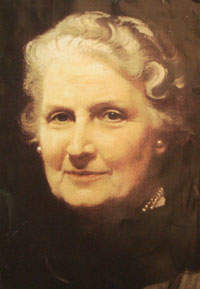Dr Maria Montessori & Her Method

After her research, she developed some teaching aids (which she called didactic materials) with which she stimulated and educated them, and brought them to par with other (steady) children. This was the beginning of Dr. Montessori’s interest in Education. In 1901, she left the field of Medicine to study anthropology, educational philosophy and experimental psychology, and in 1907 she started her first classroom, “Casa dei Bambini” (Children’s House) in San Lorenzo, Italy. She adapted some of the methods she had used with the special needs children, in the new school and further developed more learning materials that awakened their desire to learn. She achieved such great results with the Children’s House that news of the outcome of her method spread through Italy, and by 1910 Montessori schools had become acclaimed worldwide.
During her research and work with children, Dr. Montessori discovered that children demonstrate an amazing ability and capacity to learn from birth to six years. She found that at this plane of development, they are able to take in a lot of information effortlessly through their senses (just by living) and that there is no limit to the amount of information their minds (which she likened to a sponge) can absorb. This is how they learn to imitate people, acquire language(s), develop movement, learn social skills and gain knowledge of the world’s customs, values and systems.
This is why the Montessori learning environment at The Pier School has been designed to offer children countless and limitless opportunities to acquire as much knowledge as they are capable of taking in.
HOW IS THE MONTESSORI METHOD DIFFERENT FROM THE CONVENTIONAL METHOD OF EDUCATION?
Here are a few attributes that stand out the Montessori method and some of the ways it differs from the conventional method of education:
Montessori Method |
Conventional Method |
|
|
|
|
|
|
|
|
|
|
|
|
|
|
|
|
|
|
|
|
Find out more about us
Team
Our management team is made up of the school director and an advisory board. The school director manages the affairs of The Pier School with the vast wealth of insights provided by the advisory board on educational management, excellent educational service delivery, technologically enhanced education delivery, business improvement, legal perspectives, good governance, growth, and sustainability.
